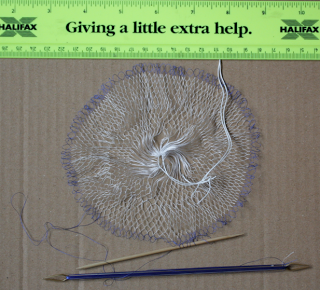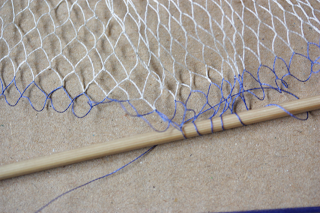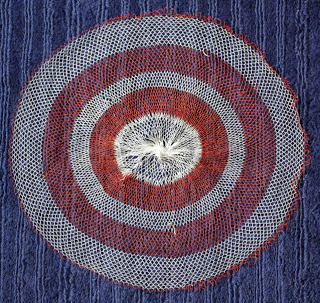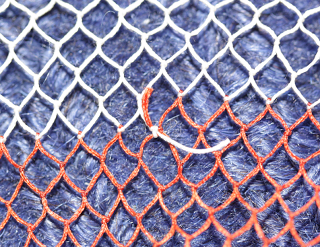That was a really pleasant, wonderful and relaxing weekend - spent mostly at home, doing necessary things for the medieval gear (like cleaning and shining shoes and washing textile stuff) at a leisurely pace, eating yummy things (like really tasty asparagus and strawberry cream cake), reading and doing some fun weaving.
The fun weaving is in preparation for a tablet weaving workshop, scheduled for August. The workshop is meant to teach people already experienced with threaded-in patterned tablet weaves how to do free patterning and double-faced weaves in twill structure, by showing the underlying mechanics of the weaving process. And in preparation of this, I'm weaving a "play-band". A band like that - used for playing around with different turning techniques and developing patterns - is what we'll weave in the workshop, to each her (or his) own play-band.
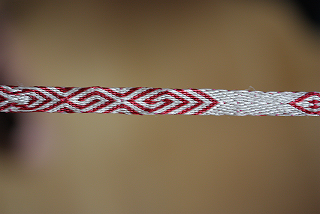
The warp I made for my preparation thing is relatively thick, plied silk yarn in red and off-white. I used the opportunity to try some patterns I had drafted from other bands before proper playing, but the hours yesterday were spent with fun combining of turning sequences, pattern pieces and twill. The thing I like most about play-bands? First of all, there are no real mistakes. You can just do things. The worst that can happen is that either you get totally blown away pattern-wise and have to turn the tablets back into starting sequence, or that you end up on the back of the band with your pattern. Then you can either tablet-turn your way up again or you just flip the band and go on where your pattern has gone to. And occasionally, there's a real nice pattern piece in the sequences that turns up by chance... and on a play-band you can take the time and space to isolate this pattern bit by placing it on a twill background.
And I had an obscene amount of fun yesterday weaving this pattern bit:
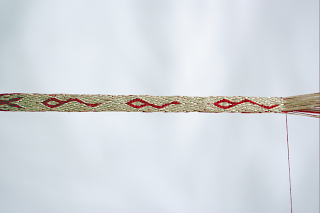
Guess which of these three will win the race?
The fun weaving is in preparation for a tablet weaving workshop, scheduled for August. The workshop is meant to teach people already experienced with threaded-in patterned tablet weaves how to do free patterning and double-faced weaves in twill structure, by showing the underlying mechanics of the weaving process. And in preparation of this, I'm weaving a "play-band". A band like that - used for playing around with different turning techniques and developing patterns - is what we'll weave in the workshop, to each her (or his) own play-band.

The warp I made for my preparation thing is relatively thick, plied silk yarn in red and off-white. I used the opportunity to try some patterns I had drafted from other bands before proper playing, but the hours yesterday were spent with fun combining of turning sequences, pattern pieces and twill. The thing I like most about play-bands? First of all, there are no real mistakes. You can just do things. The worst that can happen is that either you get totally blown away pattern-wise and have to turn the tablets back into starting sequence, or that you end up on the back of the band with your pattern. Then you can either tablet-turn your way up again or you just flip the band and go on where your pattern has gone to. And occasionally, there's a real nice pattern piece in the sequences that turns up by chance... and on a play-band you can take the time and space to isolate this pattern bit by placing it on a twill background.
And I had an obscene amount of fun yesterday weaving this pattern bit:

Guess which of these three will win the race?





